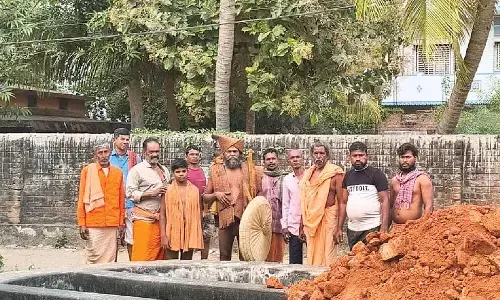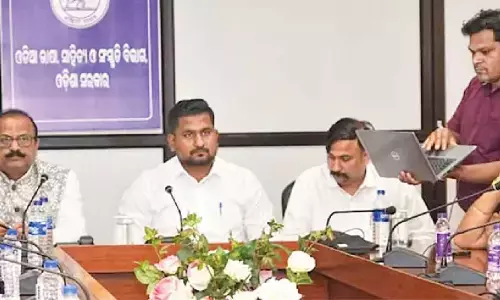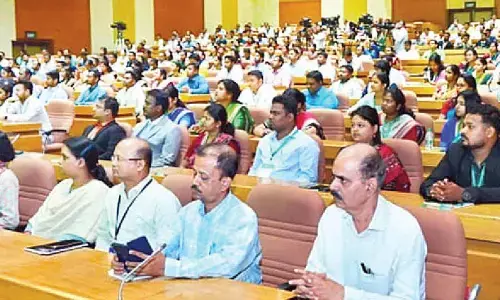On the trail of mother of rivers: The Saraswati

On the trail of mother of rivers: The Saraswati
The first civilisation formed on the banks of rivers. The early civilisations began to form around the time of the Neolithic Revolution. Rivers were attractive locations for the first civilisations because they provided a steady supply of drinking water and made the land fertile for growing crops. Moreover, they were useful for transportation of goods from one place to another. Additionally, those lost in the wilderness could return to civilisation by travelling downstream, where the major centres of human population tend to concentrate. Rivers are the backbone of human civilisation, without rivers, life will come to a halt. In India, early civilisation like Mohenjo-Daro and Lothal flourished on the bank of river Saraswati and has significant part in their development.
In recent years, a number of scientists have come out with the comprehensive studies on geomorphological, sedimentological, geochronological, hydrological and remote sensing aspects of the Saraswati River. A majority of scientists have come to the conclusion that it was a large river that had abundant discharge and brought voluminous quantity of sediments from the Himalayan province.A growing number of scientists and archaeologists believe that the Ghagghar does represent the Saraswati River of yore. The Ghagghar of Haryana is known as Hakra, in Cholistan and the Nara, in Sindh (both in eastern Pakistan). The great width of channel, coupled with thickness as much as 30-50 m of the fluvial(rock fragments entrained - fine particles, in a stream of water) - alluvial sediments deposited by the river implies that it once carried voluminous discharge of water. That mighty river at present is reduced to the Ghagghar - Hakra - Nara river in which only flood water flows.
The drainage of two rivers that once constituted the two branches of the legendary Saraswati River of prehistoric antiquity encompassed three radically different physiographic-geological provinces. One of the branches, Sutlej (earlier called Shatadru) arose in southern Tibet beyond the Himalaya, other the Tons (earlier called Tamasa) emerges in the ever-snowy Himadri or Great Himalayan domain, and the third the Chautang (Drishadwati) drained the southern foothill belt of the western Indo-Gangetic Plains. In its middle reaches the river traversed the large swathe of alluvial plain, and then passed through the dreary landscape of sand dunes of the Thar Desert, before ending in the Rann of Kutch once a part of the realm of the Arabian Sea.
A number of scientists dealing with the tectonic and seismic activities have observed that the vast expanse of land traversed by the Saraswati and its tributaries have more than once experienced tectonic convulsions and also severely shaken by earthquakes of large magnitude, resulting in displacement of ground. Some parts of it rose and the others sank along the fault that dissect it. This indeed happened to the Saraswati and its branches that followed a path riddled with active faults.
The changes that took place considerably modified the landforms so much so that it is not the same today when the Saraswati flowed during the prime of its life. Due to tectonic upheaval, entailing fissuring , sinking and uplifting of the land through the eastern branch of the Saraswati (the Tamasa River) flowed, bringing dramatic change in the drainage. As the tectonically resurgent Aravalli Orogenic belt slowly rose up, the Saraswati and its tributaries shifted progressively westward. The uplifted and displaced block impending its flow, the Tamasa found crushed and the weakened rock of fault zone cut and formed a new channel. Flowing south westward, the Tamasa branch of the Saraswati joined Drishadwati River which then the upland of Haryana.
By joining Tamasa Drishadwati became a major river. Sometimes later land in the foothills to the east of Paonta Sahab Fault (Yamuna Tear) sank. The sinking of the ground forced the then south-westward flowing river to deflect southward towards the then Yamuna, which was a tributary of Chambal - a tributary of Ganga. The Tamasa branch of Saraswati now joined the Yamuna, which became carrier of Tamasa branch of the Saraswati water and delivered to the Ganga at Prayag - a confluence of Ganga and Yamuna, now Saraswati also joined through its channel of Yamuna, it became Triveni.
The Winter Westerlies -strongest wind in winter blow from west to east, continued to provide precipitation and pile snows in the mountainous catchment of the two branches of Saraswati. The melt water sustained the flow of Saraswati in the period Harappan lived. The Harappan left their abode, when the river lost all its water due to capture of its eastern branch by Yamuna river and of its western branch by the Vipash (Beas) river, wholly depriving the Saraswati of its water discharge.
The river Saraswati had such a fascinating history, supported geological, hydrological and archaeological evidences as well as the records of the most modern tools, such as remote sensing and GIS. With the aid of remote sensing through orbiting satellites, the mystery of the river is almost solved. Rajasthan government has been doing a lot of work since the 1990s , to retrace the ancient network of channels. The Rajasthan Ground Water Department (RGWD) is assisted by Central Ground Water Board (CGWB), Indian Space Research Organisation (ISRO), Bhabha Atomic Research Center (BARC) and National Physical Laboratory, Ahmedabad.
The RGWD is investigating site of channels, CGWB is carrying out drilling activities for water and soil samples by carbon dating. The team is of the opinion that the Saraswati river enter Rajasthan in Ganganagar distinct and tail ends in Bikaner and Jaisalmer districts near Rann of Kutch. The extensive study has shown that there are big Paleochannels 60-70 meters underground and water was moving slowly towards the sea.The presence of Alluvial sediment points out towards existence of fresh water flow source along palaeochannels. These palaeochannels are present in all 10 districts of western Rajasthan and pertain to the ancient river Saraswati.
Mythologically, the Saraswati was a highly venerated river in the times it watered the vast expanse of the land known as Saptasindhav - the land of seven rivers -Saraswati, Sutlej (Satadru), Beas (Vipasa), Chenab (Asikani), Ravi (Parosni), Jhelum (Vitasta) and Sindhu (lndus) - (Rigveda 8.24.27). The Rigved describes the river Saraswati as -'naditama' - the best of all rivers (R 2.41.16), surpassing all other rivers in splendour and benevolence 'mahimanamahinar'(R 6.61.13). It was mighty river 'mahoarnah' (R 1.3.12) , abounding in water that was pure in the source of mountains to the sea, 'shuchiryatigiribhya a' - samudrat (7.95.2). It was most impetuous of all rivers 'apasamapastama' (R 6.61 13) that descended with roar 'charatiroruvat' down the slope, it's fierce current gurgling (R 6.61.7) through its canyon course. In SkandPuran, the Saraswati is shown as originating in the snowy Himalayas and flowing down to the foothills. In its way down to the plains, the river cuts through multitudes of mountain ranges, after watering Kurukshetra region the Saraswati turned westward and flowed through forests such as Sitavan 'Aditivan 'Dvaitvan etc.
Further downstream, the Pandavas during their exile and later Balram - brother of Krishna, along Saraswati river noticed that at a place Vinashan the river disappeared under the mass of sands (Mahabharata Van Parv 25.1). Balram had started his journey from the place where the 'river met the sea ' (Mahabharata Shalya Parv 35.77).
This makes clear that as per Rigveda the Saraswati originated in Himalayas and as per epic Mahabharata the river degenerated into middle reaches and went under the pile of sands in the lower reaches. In the sand desert, the Saraswati has become subterranean -an underground (antahsalila) river. The prehistoric, scientific and mythological evidence show that the Saraswati river was not a mystery. It had abundant discharge and was a venerated river. But subsequently, due to natural upheaval it got fragmented and eventually became waterless.


















